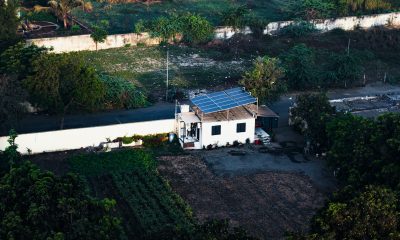Business
Collapsing construction sector in Catalonia and Barcelona
Assumpció Puig from the Association of Architects of Catalonia explained that the construction sector is in the phase of deceleration. Which is why the City Council, as well as the Generalitat, plan to devote resources to rehabilitation. It is known, that the surface area approved in 2019 reached 4.7 million square meters, non-residential construction reached 1.4 million square meters.

The construction sector is not in recession but has entered a phase of “deceleration” throughout Catalonia, especially in the city of Barcelona, Spain, and the metropolitan area. As explained by the Association of Architects of Catalonia (COAC), Assumpció Puig. This brake especially affects the construction of habitats and specifically the city of Barcelona.
The Puig managed to balance the 2019 exercise with clear criticism of the administrations: habitat restoration has not started yet continues in Europe despite the housing and climate emergency. According to the defence, the City Council and Generalitat should allocate resources for rehabilitation, especially considering that 70% of the land before 1980s does not meet the standards of isolation, sustainability, and energy efficiency.
Download the Born2Invest mobile app for the latest and most interesting news in the stock market, business news, and many more. The app provides its readers access to the latest news in global business, crowdfunding, and others.
The surface area for projects
According to the data from the College of Architects, the surface area approved for any 2019 – projects for which the College is responsible – will be 4.7 million square meters, 4.8% more than the previous year. Despite the growth, the figures show a clear deceleration after years of two-digit growth.
However, if it is separated by the type the of surface, it is seen the deceleration of the habitat, since the past year had projects of new work or rehabilitation in all of Catalonia with a total of 3.2 million square meters, only 0.7% more than the previous year. In contrast, non-residential construction will reach 1.4 million square meters, with a growth of 13.7%, “Tertiary growth and not housing, when the country is in an emergency situation,” stressed the COAC’s statement.
The slowdown in the construction of housing is especially noticeable in Barcelona. Contrary to what has happened in the last five years, the surface area of the apartments in the Catalan capital has increased by 15.6%, while the number of projects has increased by 3.3% and the number of apartments by 12%, something that the COAC attributes to the fact that the apartments are getting smaller every year.
The event has demystified the forecast of processing of visas and building permits for Barcelona during 2019, of the projects that were presented at the end of 2018, to avoid the regulations that oblige to reserve 30% of the apartments for social housing. According to this, many promoters are going to present appeals against the regulations and are waiting for the resolution of the courts.
Moreover, Assumpció Puig, has highlighted that the growth of the tertiary sector was a phenomenon above the residential sector that occurred mainly in Barcelona, due to the promotion of office projects, but this is in the metropolitan area. The tertiary sector is the driving force behind the construction of the entire conurbation of Barcelona.
The conference highlighted that during 2019, projects to build 15,853 homes have been approved for all of Catalonia, while the Housing Agency has set that by 2020-2024, 26,300 homes will be built annually in the Principality to meet its needs.
The COAC has also criticized the slowness of the councils in granting building licenses with cases in which the delay was longer than 12 months. As a result, it is difficult to invest, said Joan Tous, head of the Tarragona region of the COAC, for two reasons: investors do not want to have long projects and because they decide to add other places at the cost of opportunity.
The average time to obtain a license in Catalonia is 5.6 months. The fastest municipalities are Figueres, Matadepera, Reus and Sant Pere de Ribes, while the slowest are Sabadell, Rubí, and Sitges. In the city of Barcelona the waiting time is 5.1 months, but with great differences by districts. The slowest ones are Ciutat Vella and l’Eixample, where it can take up to a year.
__
(Featured image by Federico Respini via Unsplash)
DISCLAIMER: This article was written by a third party contributor and does not reflect the opinion of Born2Invest, its management, staff or its associates. Please review our disclaimer for more information.
This article may include forward-looking statements. These forward-looking statements generally are identified by the words “believe,” “project,” “estimate,” “become,” “plan,” “will,” and similar expressions. These forward-looking statements involve known and unknown risks as well as uncertainties, including those discussed in the following cautionary statements and elsewhere in this article and on this site. Although the Company may believe that its expectations are based on reasonable assumptions, the actual results that the Company may achieve may differ materially from any forward-looking statements, which reflect the opinions of the management of the Company only as of the date hereof. Additionally, please make sure to read these important disclosures.
First published in economia, a third-party contributor translated and adapted the article from the original. In case of discrepancy, the original will prevail.
Although we made reasonable efforts to provide accurate translations, some parts may be incorrect. Born2Invest assumes no responsibility for errors, omissions or ambiguities in the translations provided on this website. Any person or entity relying on translated content does so at their own risk. Born2Invest is not responsible for losses caused by such reliance on the accuracy or reliability of translated information. If you wish to report an error or inaccuracy in the translation, we encourage you to contact us.

-

 Crowdfunding1 week ago
Crowdfunding1 week agoPMG Empowers Italian SMEs with Performance Marketing and Investor-Friendly Crowdfunding
-

 Markets5 days ago
Markets5 days agoMarkets Wobble After Highs as Tariffs Rise and Commodities Soar
-

 Markets2 weeks ago
Markets2 weeks agoThe Big Beautiful Bill: Market Highs Mask Debt and Divergence
-

 Africa2 days ago
Africa2 days agoORA Technologies Secures $7.5M from Local Investors, Boosting Morocco’s Tech Independence

























